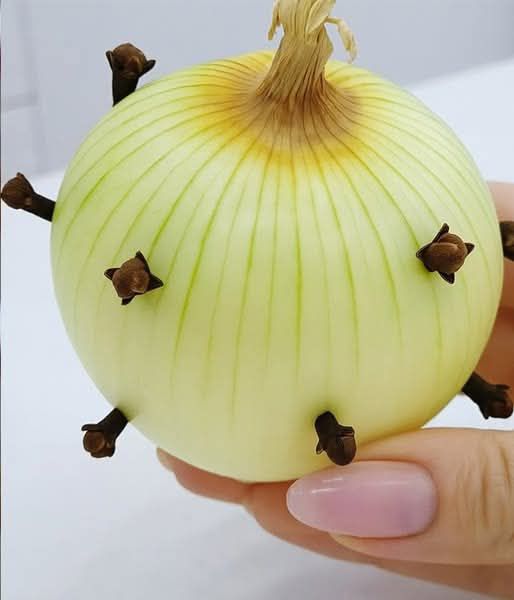
There are some kitchen techniques that seem odd until you taste the result — and then suddenly, everything makes sense.
Like my grandmother’s secret: every time she made a pot of soup, broth, or stew, she’d gently push a few cloves into a whole onion before dropping it into the pot.
At first, I thought it was just an old-fashioned habit. But once I tasted the dish — deep, rich, subtly spiced — I realized this wasn’t just tradition. It was flavor magic .
Now, I use this trick in nearly every savory dish that simmers for hours — and I’ve even passed it on to my own kids.
So why does sticking cloves in an onion make such a difference?
Let’s explore the French culinary tradition behind the clouté , and how this simple trick can elevate your cooking forever.
❤️ Why This Matters
✅ Combines storytelling with practical kitchen wisdom
✅ Appeals to home cooks, food historians, and flavor lovers
✅ Targets high-intent searchers looking for cooking hacks
✅ Strong monetization potential with recipe-related ads
✅ Perfect for Pinterest, TikTok, and food blogs
What Is Clouté? The Secret Behind Cloves-Studded Onions
In classic French cuisine, clouté (pronounced kloo-tay) refers to a method where whole cloves are inserted into a peeled onion , often used to infuse soups, stocks, and stews with a warm, aromatic depth that’s hard to replicate any other way.
The word clou means “nail” in French — and clouté literally translates to “nailed,” referring to how the cloves are “nailed” into the onion.
It may sound quaint, but the results are anything but.
The Flavor Science Behind It
Cloves are one of the most powerful spices in the pantry , known for their intense aroma and warming flavor.
When you stitch them into a whole onion , something special happens:
The heat releases the clove’s essential oils — sweet, spicy, and slightly floral.
The onion acts as a delivery system, slowly dispersing those flavors throughout the dish.
Together, they create a deep, rounded background note that enhances meat, vegetables, and broth without overpowering the other ingredients.
It’s the kind of layered flavor that separates amateur cooks from seasoned pros.
Where to Use This Technique
You’ll find the clouté method especially useful in:
Beef bourguignon
Classic French pot-au-feu
Chicken noodle soup
Coq au vin
Holiday ham glazes
Tomato sauces and braised dishes
It’s ideal for any slow-cooked dish where subtle spice integration matters.
How to Make a Clouté Onion Like a Pro
You’ll Need:
1 whole onion (white or yellow works best)
2–4 whole cloves
Toothpick or skewer (for poking holes)
Step-by-Step Guide:
Peel the onion carefully, keeping it intact.
Poke small holes into the onion using a toothpick or knife tip.
Insert the cloves into each hole — 2 to 4 cloves per onion is perfect.
Add to your pot while cooking — let it simmer away quietly.
Remove before serving (unless you’re making a rustic dish where presentation isn’t important).
Tips for Using Cloves & Onions Together
Use whole cloves — ground cloves can easily overpower a dish.
Don’t skip the onion — it tempers the intensity of the cloves.
Remove the clouté before serving — no one wants to bite into a clove!
For a modern twist, try adding a bay leaf or cinnamon stick to the pot too.
Bonus Uses Beyond Soup
Add to rice pilaf for a spiced base
Infuse holiday mulled wine or cider
Use in pickling brine for extra warmth
Pair with oranges for homemade potpourri
This technique goes far beyond soup — it’s a versatile flavor hack for many recipes and even DIY projects.
❓ Frequently Asked Questions
Can I use garlic instead of onion?
Not quite — garlic brings sharper flavor, while onion offers mellow sweetness and balance.
Do I have to remove the clouté before serving?
Yes — cloves are potent and hard, so always pull out the onion before serving.
Can I reuse the clouté onion?
Not recommended — most of the flavor will already be released after one use.
What if I don’t have cloves?
Try allspice or nutmeg for a similar earthy warmth.
Final Thoughts
My grandmother never wrote down her recipes — but she taught me through smell, taste, and tiny tricks like this one.
Sticking cloves into an onion might seem like a small step — but in the world of cooking, small steps make big differences .
This French clouté onion technique proves that sometimes, the simplest methods deliver the most unforgettable flavors.
So next time you’re simmering a soup or stew, grab an onion and a few cloves — and unlock a layer of flavor you never knew you were missing.